Nursing Report: Personal Experiences, Bias, and Education in Nursing
VerifiedAdded on 2022/08/24
|7
|2212
|21
Report
AI Summary
This report examines the critical aspects of elderly care within the nursing profession, focusing on the impact of personal experiences, biases in healthcare delivery, and the development of a community education plan. The author reflects on how interactions with diverse patient groups, including the elderly, have shaped their nursing practice, enhancing communication, interpersonal skills, and cultural awareness. The report highlights instances of ageism and bias encountered in clinical settings, such as insensitive treatment and employment discrimination against elderly nurses. To address these issues, the report proposes a community education plan targeting different age groups, emphasizing the importance of respecting and understanding the elderly, promoting awareness of aging, and fostering a supportive environment. The goal is to mitigate discrimination and improve the quality of care for the elderly population.
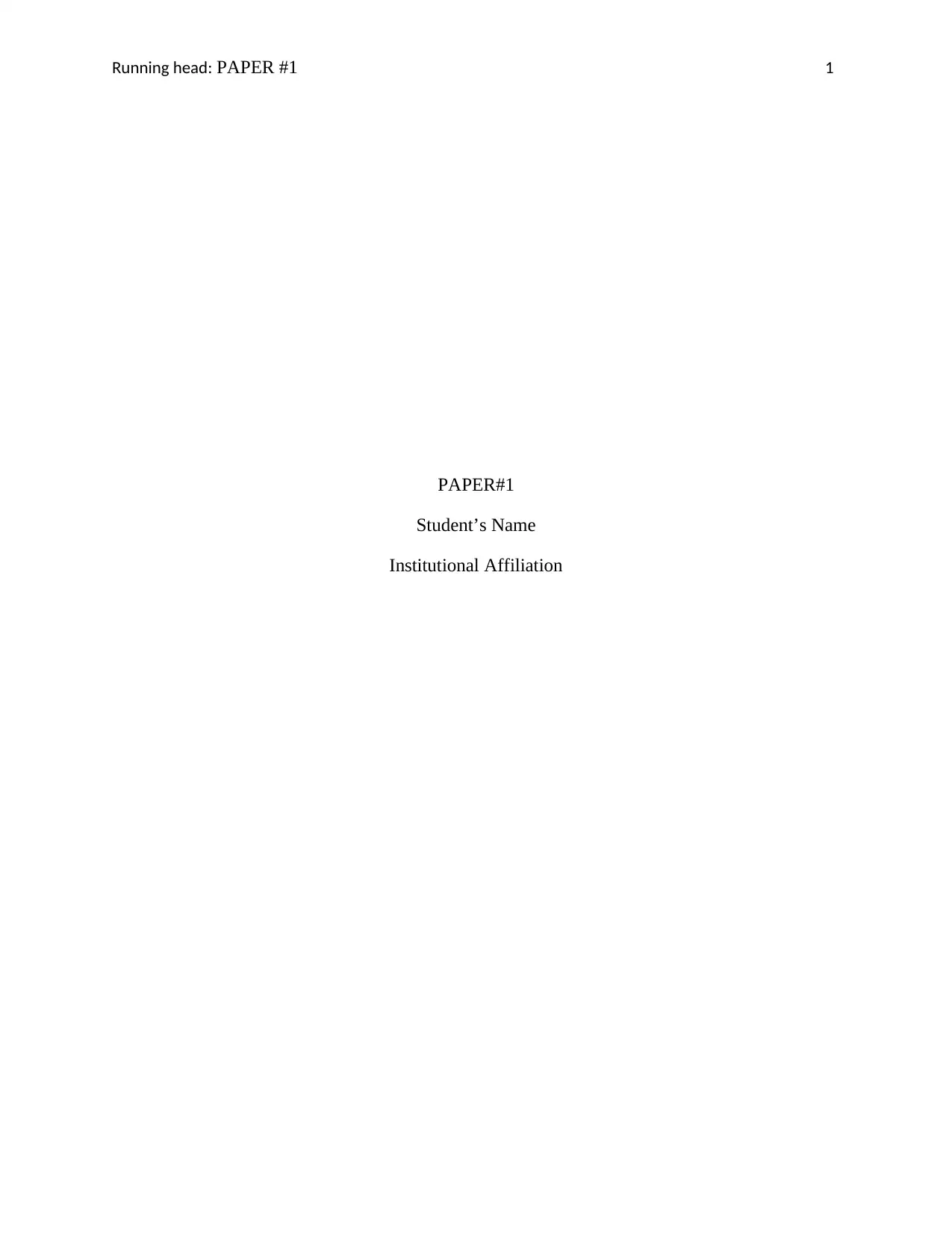
Running head: PAPER #1 1
PAPER#1
Student’s Name
Institutional Affiliation
PAPER#1
Student’s Name
Institutional Affiliation
Paraphrase This Document
Need a fresh take? Get an instant paraphrase of this document with our AI Paraphraser
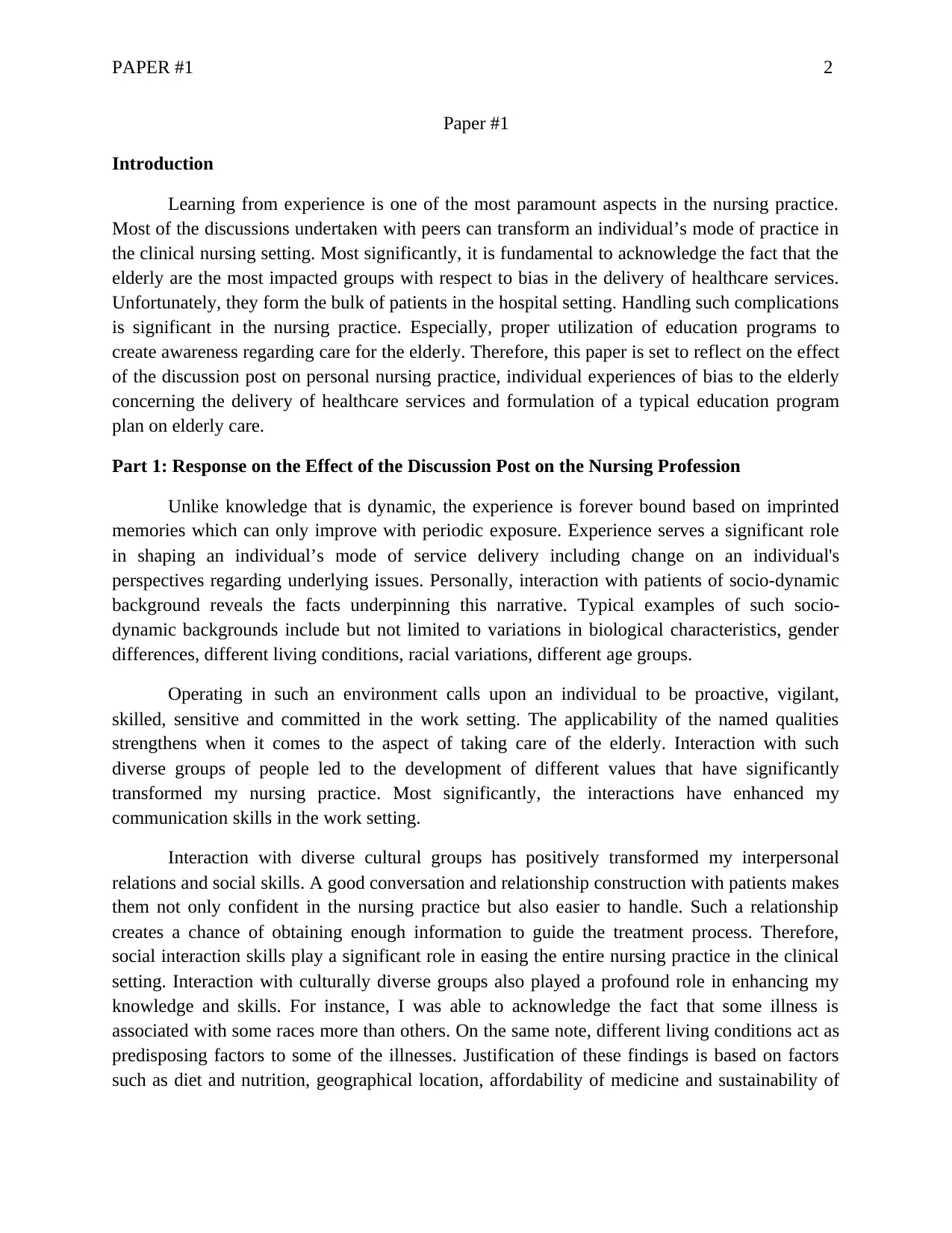
PAPER #1 2
Paper #1
Introduction
Learning from experience is one of the most paramount aspects in the nursing practice.
Most of the discussions undertaken with peers can transform an individual’s mode of practice in
the clinical nursing setting. Most significantly, it is fundamental to acknowledge the fact that the
elderly are the most impacted groups with respect to bias in the delivery of healthcare services.
Unfortunately, they form the bulk of patients in the hospital setting. Handling such complications
is significant in the nursing practice. Especially, proper utilization of education programs to
create awareness regarding care for the elderly. Therefore, this paper is set to reflect on the effect
of the discussion post on personal nursing practice, individual experiences of bias to the elderly
concerning the delivery of healthcare services and formulation of a typical education program
plan on elderly care.
Part 1: Response on the Effect of the Discussion Post on the Nursing Profession
Unlike knowledge that is dynamic, the experience is forever bound based on imprinted
memories which can only improve with periodic exposure. Experience serves a significant role
in shaping an individual’s mode of service delivery including change on an individual's
perspectives regarding underlying issues. Personally, interaction with patients of socio-dynamic
background reveals the facts underpinning this narrative. Typical examples of such socio-
dynamic backgrounds include but not limited to variations in biological characteristics, gender
differences, different living conditions, racial variations, different age groups.
Operating in such an environment calls upon an individual to be proactive, vigilant,
skilled, sensitive and committed in the work setting. The applicability of the named qualities
strengthens when it comes to the aspect of taking care of the elderly. Interaction with such
diverse groups of people led to the development of different values that have significantly
transformed my nursing practice. Most significantly, the interactions have enhanced my
communication skills in the work setting.
Interaction with diverse cultural groups has positively transformed my interpersonal
relations and social skills. A good conversation and relationship construction with patients makes
them not only confident in the nursing practice but also easier to handle. Such a relationship
creates a chance of obtaining enough information to guide the treatment process. Therefore,
social interaction skills play a significant role in easing the entire nursing practice in the clinical
setting. Interaction with culturally diverse groups also played a profound role in enhancing my
knowledge and skills. For instance, I was able to acknowledge the fact that some illness is
associated with some races more than others. On the same note, different living conditions act as
predisposing factors to some of the illnesses. Justification of these findings is based on factors
such as diet and nutrition, geographical location, affordability of medicine and sustainability of
Paper #1
Introduction
Learning from experience is one of the most paramount aspects in the nursing practice.
Most of the discussions undertaken with peers can transform an individual’s mode of practice in
the clinical nursing setting. Most significantly, it is fundamental to acknowledge the fact that the
elderly are the most impacted groups with respect to bias in the delivery of healthcare services.
Unfortunately, they form the bulk of patients in the hospital setting. Handling such complications
is significant in the nursing practice. Especially, proper utilization of education programs to
create awareness regarding care for the elderly. Therefore, this paper is set to reflect on the effect
of the discussion post on personal nursing practice, individual experiences of bias to the elderly
concerning the delivery of healthcare services and formulation of a typical education program
plan on elderly care.
Part 1: Response on the Effect of the Discussion Post on the Nursing Profession
Unlike knowledge that is dynamic, the experience is forever bound based on imprinted
memories which can only improve with periodic exposure. Experience serves a significant role
in shaping an individual’s mode of service delivery including change on an individual's
perspectives regarding underlying issues. Personally, interaction with patients of socio-dynamic
background reveals the facts underpinning this narrative. Typical examples of such socio-
dynamic backgrounds include but not limited to variations in biological characteristics, gender
differences, different living conditions, racial variations, different age groups.
Operating in such an environment calls upon an individual to be proactive, vigilant,
skilled, sensitive and committed in the work setting. The applicability of the named qualities
strengthens when it comes to the aspect of taking care of the elderly. Interaction with such
diverse groups of people led to the development of different values that have significantly
transformed my nursing practice. Most significantly, the interactions have enhanced my
communication skills in the work setting.
Interaction with diverse cultural groups has positively transformed my interpersonal
relations and social skills. A good conversation and relationship construction with patients makes
them not only confident in the nursing practice but also easier to handle. Such a relationship
creates a chance of obtaining enough information to guide the treatment process. Therefore,
social interaction skills play a significant role in easing the entire nursing practice in the clinical
setting. Interaction with culturally diverse groups also played a profound role in enhancing my
knowledge and skills. For instance, I was able to acknowledge the fact that some illness is
associated with some races more than others. On the same note, different living conditions act as
predisposing factors to some of the illnesses. Justification of these findings is based on factors
such as diet and nutrition, geographical location, affordability of medicine and sustainability of
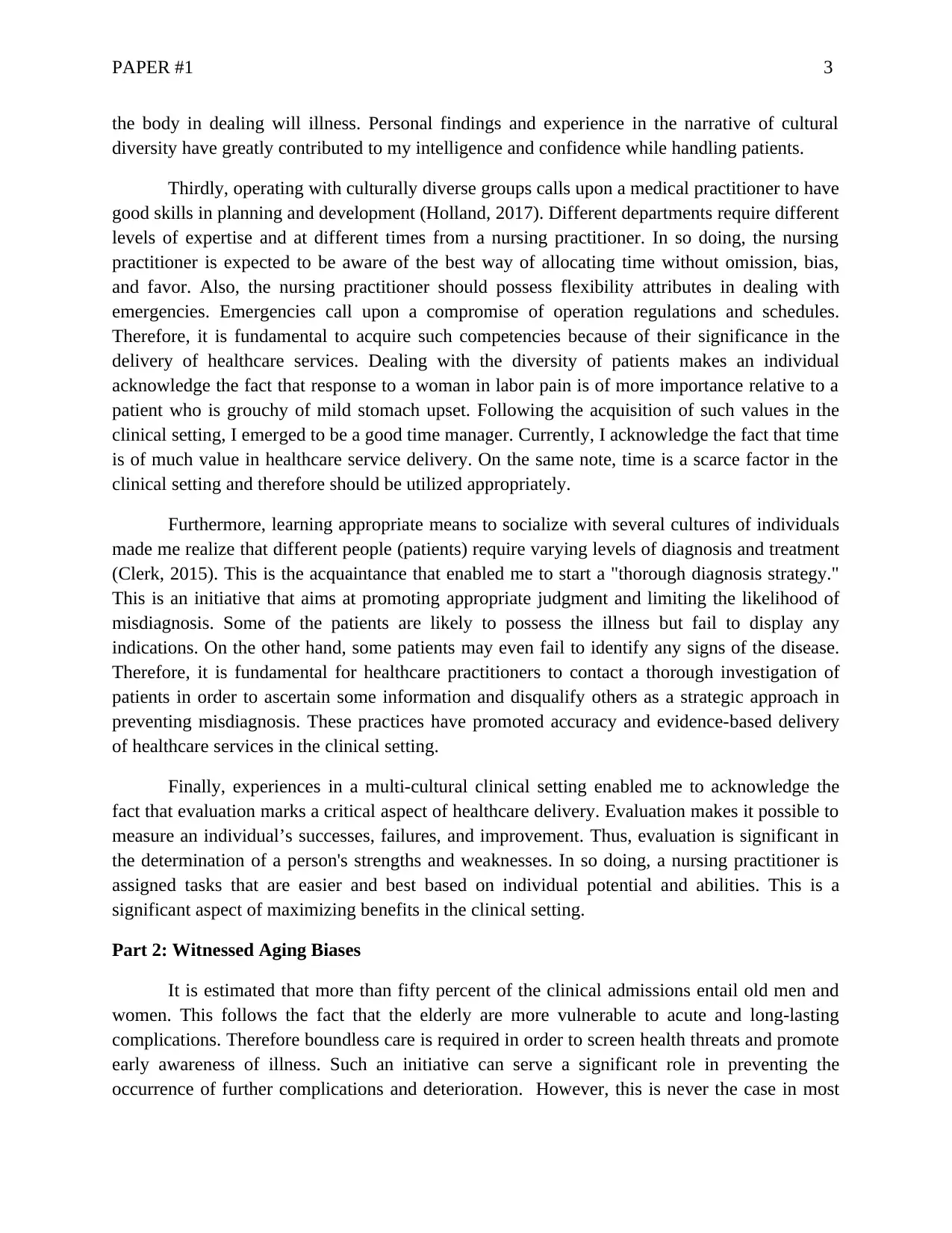
PAPER #1 3
the body in dealing will illness. Personal findings and experience in the narrative of cultural
diversity have greatly contributed to my intelligence and confidence while handling patients.
Thirdly, operating with culturally diverse groups calls upon a medical practitioner to have
good skills in planning and development (Holland, 2017). Different departments require different
levels of expertise and at different times from a nursing practitioner. In so doing, the nursing
practitioner is expected to be aware of the best way of allocating time without omission, bias,
and favor. Also, the nursing practitioner should possess flexibility attributes in dealing with
emergencies. Emergencies call upon a compromise of operation regulations and schedules.
Therefore, it is fundamental to acquire such competencies because of their significance in the
delivery of healthcare services. Dealing with the diversity of patients makes an individual
acknowledge the fact that response to a woman in labor pain is of more importance relative to a
patient who is grouchy of mild stomach upset. Following the acquisition of such values in the
clinical setting, I emerged to be a good time manager. Currently, I acknowledge the fact that time
is of much value in healthcare service delivery. On the same note, time is a scarce factor in the
clinical setting and therefore should be utilized appropriately.
Furthermore, learning appropriate means to socialize with several cultures of individuals
made me realize that different people (patients) require varying levels of diagnosis and treatment
(Clerk, 2015). This is the acquaintance that enabled me to start a "thorough diagnosis strategy."
This is an initiative that aims at promoting appropriate judgment and limiting the likelihood of
misdiagnosis. Some of the patients are likely to possess the illness but fail to display any
indications. On the other hand, some patients may even fail to identify any signs of the disease.
Therefore, it is fundamental for healthcare practitioners to contact a thorough investigation of
patients in order to ascertain some information and disqualify others as a strategic approach in
preventing misdiagnosis. These practices have promoted accuracy and evidence-based delivery
of healthcare services in the clinical setting.
Finally, experiences in a multi-cultural clinical setting enabled me to acknowledge the
fact that evaluation marks a critical aspect of healthcare delivery. Evaluation makes it possible to
measure an individual’s successes, failures, and improvement. Thus, evaluation is significant in
the determination of a person's strengths and weaknesses. In so doing, a nursing practitioner is
assigned tasks that are easier and best based on individual potential and abilities. This is a
significant aspect of maximizing benefits in the clinical setting.
Part 2: Witnessed Aging Biases
It is estimated that more than fifty percent of the clinical admissions entail old men and
women. This follows the fact that the elderly are more vulnerable to acute and long-lasting
complications. Therefore boundless care is required in order to screen health threats and promote
early awareness of illness. Such an initiative can serve a significant role in preventing the
occurrence of further complications and deterioration. However, this is never the case in most
the body in dealing will illness. Personal findings and experience in the narrative of cultural
diversity have greatly contributed to my intelligence and confidence while handling patients.
Thirdly, operating with culturally diverse groups calls upon a medical practitioner to have
good skills in planning and development (Holland, 2017). Different departments require different
levels of expertise and at different times from a nursing practitioner. In so doing, the nursing
practitioner is expected to be aware of the best way of allocating time without omission, bias,
and favor. Also, the nursing practitioner should possess flexibility attributes in dealing with
emergencies. Emergencies call upon a compromise of operation regulations and schedules.
Therefore, it is fundamental to acquire such competencies because of their significance in the
delivery of healthcare services. Dealing with the diversity of patients makes an individual
acknowledge the fact that response to a woman in labor pain is of more importance relative to a
patient who is grouchy of mild stomach upset. Following the acquisition of such values in the
clinical setting, I emerged to be a good time manager. Currently, I acknowledge the fact that time
is of much value in healthcare service delivery. On the same note, time is a scarce factor in the
clinical setting and therefore should be utilized appropriately.
Furthermore, learning appropriate means to socialize with several cultures of individuals
made me realize that different people (patients) require varying levels of diagnosis and treatment
(Clerk, 2015). This is the acquaintance that enabled me to start a "thorough diagnosis strategy."
This is an initiative that aims at promoting appropriate judgment and limiting the likelihood of
misdiagnosis. Some of the patients are likely to possess the illness but fail to display any
indications. On the other hand, some patients may even fail to identify any signs of the disease.
Therefore, it is fundamental for healthcare practitioners to contact a thorough investigation of
patients in order to ascertain some information and disqualify others as a strategic approach in
preventing misdiagnosis. These practices have promoted accuracy and evidence-based delivery
of healthcare services in the clinical setting.
Finally, experiences in a multi-cultural clinical setting enabled me to acknowledge the
fact that evaluation marks a critical aspect of healthcare delivery. Evaluation makes it possible to
measure an individual’s successes, failures, and improvement. Thus, evaluation is significant in
the determination of a person's strengths and weaknesses. In so doing, a nursing practitioner is
assigned tasks that are easier and best based on individual potential and abilities. This is a
significant aspect of maximizing benefits in the clinical setting.
Part 2: Witnessed Aging Biases
It is estimated that more than fifty percent of the clinical admissions entail old men and
women. This follows the fact that the elderly are more vulnerable to acute and long-lasting
complications. Therefore boundless care is required in order to screen health threats and promote
early awareness of illness. Such an initiative can serve a significant role in preventing the
occurrence of further complications and deterioration. However, this is never the case in most
⊘ This is a preview!⊘
Do you want full access?
Subscribe today to unlock all pages.

Trusted by 1+ million students worldwide
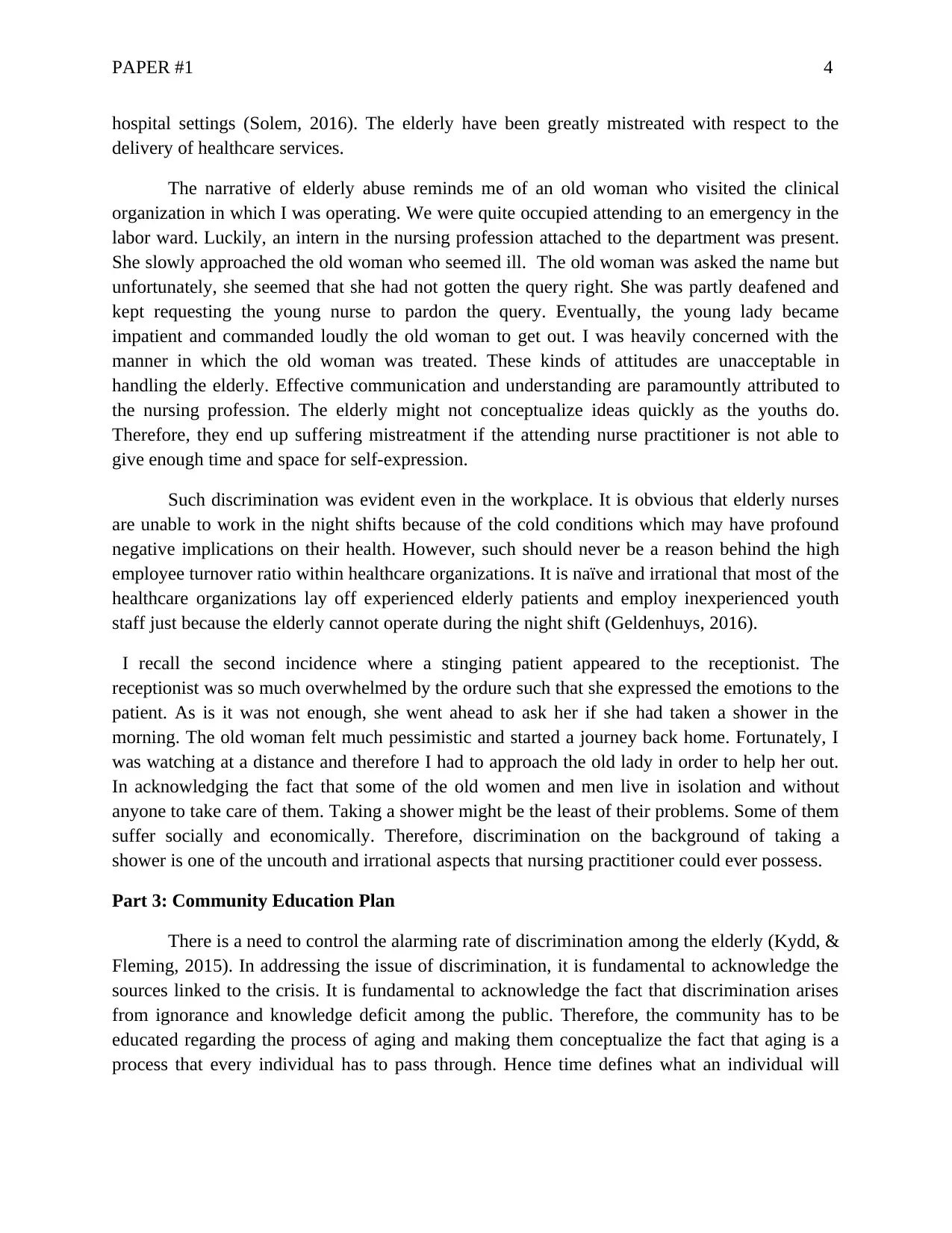
PAPER #1 4
hospital settings (Solem, 2016). The elderly have been greatly mistreated with respect to the
delivery of healthcare services.
The narrative of elderly abuse reminds me of an old woman who visited the clinical
organization in which I was operating. We were quite occupied attending to an emergency in the
labor ward. Luckily, an intern in the nursing profession attached to the department was present.
She slowly approached the old woman who seemed ill. The old woman was asked the name but
unfortunately, she seemed that she had not gotten the query right. She was partly deafened and
kept requesting the young nurse to pardon the query. Eventually, the young lady became
impatient and commanded loudly the old woman to get out. I was heavily concerned with the
manner in which the old woman was treated. These kinds of attitudes are unacceptable in
handling the elderly. Effective communication and understanding are paramountly attributed to
the nursing profession. The elderly might not conceptualize ideas quickly as the youths do.
Therefore, they end up suffering mistreatment if the attending nurse practitioner is not able to
give enough time and space for self-expression.
Such discrimination was evident even in the workplace. It is obvious that elderly nurses
are unable to work in the night shifts because of the cold conditions which may have profound
negative implications on their health. However, such should never be a reason behind the high
employee turnover ratio within healthcare organizations. It is naïve and irrational that most of the
healthcare organizations lay off experienced elderly patients and employ inexperienced youth
staff just because the elderly cannot operate during the night shift (Geldenhuys, 2016).
I recall the second incidence where a stinging patient appeared to the receptionist. The
receptionist was so much overwhelmed by the ordure such that she expressed the emotions to the
patient. As is it was not enough, she went ahead to ask her if she had taken a shower in the
morning. The old woman felt much pessimistic and started a journey back home. Fortunately, I
was watching at a distance and therefore I had to approach the old lady in order to help her out.
In acknowledging the fact that some of the old women and men live in isolation and without
anyone to take care of them. Taking a shower might be the least of their problems. Some of them
suffer socially and economically. Therefore, discrimination on the background of taking a
shower is one of the uncouth and irrational aspects that nursing practitioner could ever possess.
Part 3: Community Education Plan
There is a need to control the alarming rate of discrimination among the elderly (Kydd, &
Fleming, 2015). In addressing the issue of discrimination, it is fundamental to acknowledge the
sources linked to the crisis. It is fundamental to acknowledge the fact that discrimination arises
from ignorance and knowledge deficit among the public. Therefore, the community has to be
educated regarding the process of aging and making them conceptualize the fact that aging is a
process that every individual has to pass through. Hence time defines what an individual will
hospital settings (Solem, 2016). The elderly have been greatly mistreated with respect to the
delivery of healthcare services.
The narrative of elderly abuse reminds me of an old woman who visited the clinical
organization in which I was operating. We were quite occupied attending to an emergency in the
labor ward. Luckily, an intern in the nursing profession attached to the department was present.
She slowly approached the old woman who seemed ill. The old woman was asked the name but
unfortunately, she seemed that she had not gotten the query right. She was partly deafened and
kept requesting the young nurse to pardon the query. Eventually, the young lady became
impatient and commanded loudly the old woman to get out. I was heavily concerned with the
manner in which the old woman was treated. These kinds of attitudes are unacceptable in
handling the elderly. Effective communication and understanding are paramountly attributed to
the nursing profession. The elderly might not conceptualize ideas quickly as the youths do.
Therefore, they end up suffering mistreatment if the attending nurse practitioner is not able to
give enough time and space for self-expression.
Such discrimination was evident even in the workplace. It is obvious that elderly nurses
are unable to work in the night shifts because of the cold conditions which may have profound
negative implications on their health. However, such should never be a reason behind the high
employee turnover ratio within healthcare organizations. It is naïve and irrational that most of the
healthcare organizations lay off experienced elderly patients and employ inexperienced youth
staff just because the elderly cannot operate during the night shift (Geldenhuys, 2016).
I recall the second incidence where a stinging patient appeared to the receptionist. The
receptionist was so much overwhelmed by the ordure such that she expressed the emotions to the
patient. As is it was not enough, she went ahead to ask her if she had taken a shower in the
morning. The old woman felt much pessimistic and started a journey back home. Fortunately, I
was watching at a distance and therefore I had to approach the old lady in order to help her out.
In acknowledging the fact that some of the old women and men live in isolation and without
anyone to take care of them. Taking a shower might be the least of their problems. Some of them
suffer socially and economically. Therefore, discrimination on the background of taking a
shower is one of the uncouth and irrational aspects that nursing practitioner could ever possess.
Part 3: Community Education Plan
There is a need to control the alarming rate of discrimination among the elderly (Kydd, &
Fleming, 2015). In addressing the issue of discrimination, it is fundamental to acknowledge the
sources linked to the crisis. It is fundamental to acknowledge the fact that discrimination arises
from ignorance and knowledge deficit among the public. Therefore, the community has to be
educated regarding the process of aging and making them conceptualize the fact that aging is a
process that every individual has to pass through. Hence time defines what an individual will
Paraphrase This Document
Need a fresh take? Get an instant paraphrase of this document with our AI Paraphraser
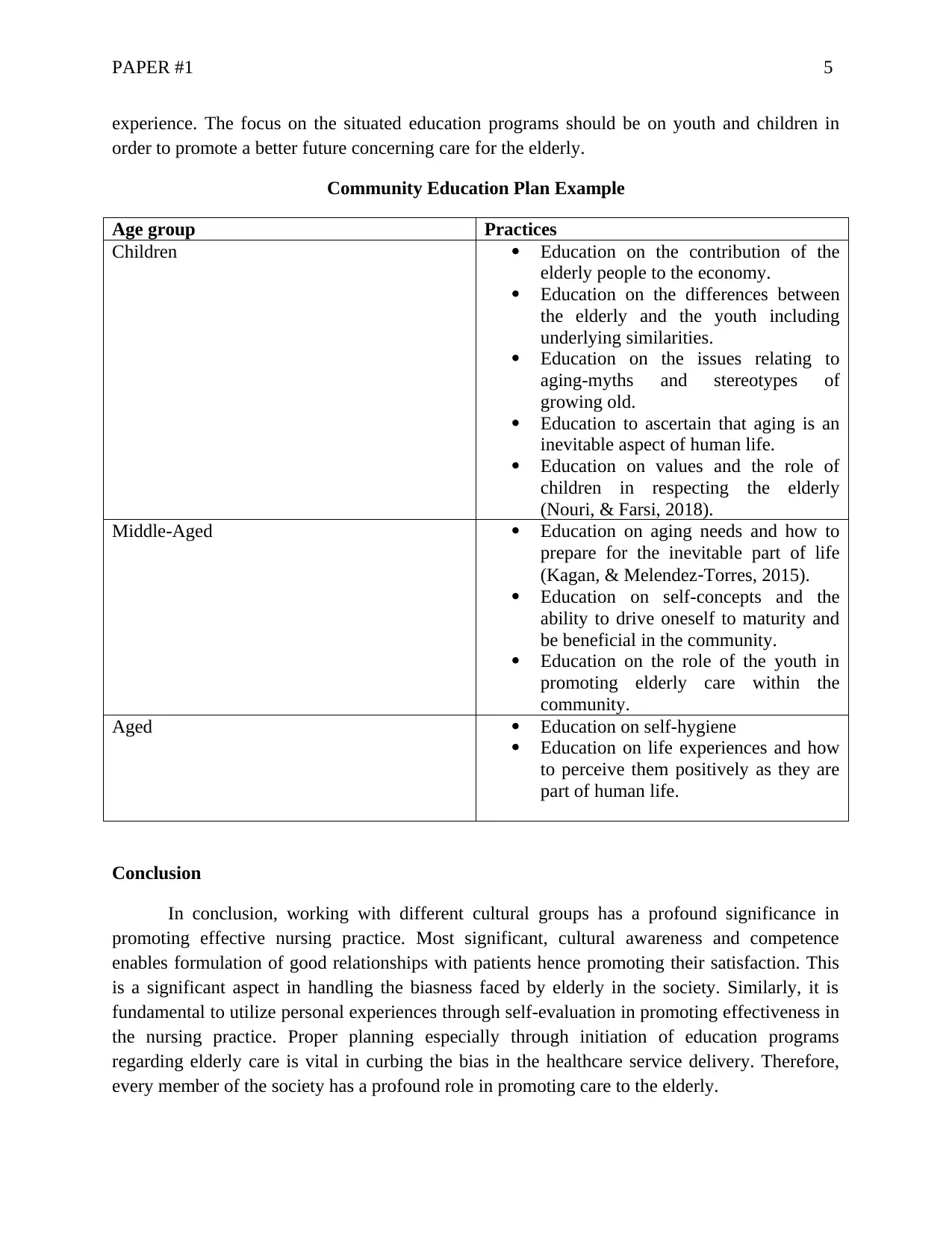
PAPER #1 5
experience. The focus on the situated education programs should be on youth and children in
order to promote a better future concerning care for the elderly.
Community Education Plan Example
Age group Practices
Children Education on the contribution of the
elderly people to the economy.
Education on the differences between
the elderly and the youth including
underlying similarities.
Education on the issues relating to
aging-myths and stereotypes of
growing old.
Education to ascertain that aging is an
inevitable aspect of human life.
Education on values and the role of
children in respecting the elderly
(Nouri, & Farsi, 2018).
Middle-Aged Education on aging needs and how to
prepare for the inevitable part of life
(Kagan, & Melendez‐Torres, 2015).
Education on self-concepts and the
ability to drive oneself to maturity and
be beneficial in the community.
Education on the role of the youth in
promoting elderly care within the
community.
Aged Education on self-hygiene
Education on life experiences and how
to perceive them positively as they are
part of human life.
Conclusion
In conclusion, working with different cultural groups has a profound significance in
promoting effective nursing practice. Most significant, cultural awareness and competence
enables formulation of good relationships with patients hence promoting their satisfaction. This
is a significant aspect in handling the biasness faced by elderly in the society. Similarly, it is
fundamental to utilize personal experiences through self-evaluation in promoting effectiveness in
the nursing practice. Proper planning especially through initiation of education programs
regarding elderly care is vital in curbing the bias in the healthcare service delivery. Therefore,
every member of the society has a profound role in promoting care to the elderly.
experience. The focus on the situated education programs should be on youth and children in
order to promote a better future concerning care for the elderly.
Community Education Plan Example
Age group Practices
Children Education on the contribution of the
elderly people to the economy.
Education on the differences between
the elderly and the youth including
underlying similarities.
Education on the issues relating to
aging-myths and stereotypes of
growing old.
Education to ascertain that aging is an
inevitable aspect of human life.
Education on values and the role of
children in respecting the elderly
(Nouri, & Farsi, 2018).
Middle-Aged Education on aging needs and how to
prepare for the inevitable part of life
(Kagan, & Melendez‐Torres, 2015).
Education on self-concepts and the
ability to drive oneself to maturity and
be beneficial in the community.
Education on the role of the youth in
promoting elderly care within the
community.
Aged Education on self-hygiene
Education on life experiences and how
to perceive them positively as they are
part of human life.
Conclusion
In conclusion, working with different cultural groups has a profound significance in
promoting effective nursing practice. Most significant, cultural awareness and competence
enables formulation of good relationships with patients hence promoting their satisfaction. This
is a significant aspect in handling the biasness faced by elderly in the society. Similarly, it is
fundamental to utilize personal experiences through self-evaluation in promoting effectiveness in
the nursing practice. Proper planning especially through initiation of education programs
regarding elderly care is vital in curbing the bias in the healthcare service delivery. Therefore,
every member of the society has a profound role in promoting care to the elderly.

PAPER #1 6
References
Clerk, J. M. (2015). Population and Community Health Nursing [online]. Retrieved from:
https://drive.google.com/file/d/17XfzaYJQVncDD8g7nqgPRrwVwyo6Raro/view
Geldenhuys, J. (2016). Challenges faced by an aging South Africa. In Ageing Populations and
Changing Labour Markets (pp. 203-228). Routledge. Retrievd from:
https://www.taylorfrancis.com/books/e/9781315566214/chapters/10.4324%2F9781315566214
-13
Holland, K. (2017). Cultural awareness in nursing and health care: an introductory text.
Routledge. Retrieved from:
https://dl.uswr.ac.ir/bitstream/Hannan/32531/1/9781138627192.pdf
Kagan, S. H., & Melendez‐Torres, G. J. (2015). Ageism in nursing. Journal of Nursing
Management, 23(5), 644-650. Retrieved from:
https://onlinelibrary.wiley.com/doi/abs/10.1111/jonm.12191
Kydd, A., & Fleming, A. (2015). Ageism and age discrimination in health care: Fact or fiction?
A narrative review of the literature. Maturitas, 81(4), 432-438. Retrieved from:
https://www.researchgate.net/profile/Angela_Kydd/publication/272468618_Quality_of_life_in
_care_The_resident%27s_perspective/links/556eb32c08aefcb861dba101.pdf
Nouri, A., & Farsi, S. (2018). Expectations of institutionalized elderly from their
children. Iranian Journal of Ageing, 13(2), 262-279. Retrieved from:
http://salmandj.uswr.ac.ir/browse.php?a_id=1396&slc_lang=en&sid=en&ftxt=1&html=1
References
Clerk, J. M. (2015). Population and Community Health Nursing [online]. Retrieved from:
https://drive.google.com/file/d/17XfzaYJQVncDD8g7nqgPRrwVwyo6Raro/view
Geldenhuys, J. (2016). Challenges faced by an aging South Africa. In Ageing Populations and
Changing Labour Markets (pp. 203-228). Routledge. Retrievd from:
https://www.taylorfrancis.com/books/e/9781315566214/chapters/10.4324%2F9781315566214
-13
Holland, K. (2017). Cultural awareness in nursing and health care: an introductory text.
Routledge. Retrieved from:
https://dl.uswr.ac.ir/bitstream/Hannan/32531/1/9781138627192.pdf
Kagan, S. H., & Melendez‐Torres, G. J. (2015). Ageism in nursing. Journal of Nursing
Management, 23(5), 644-650. Retrieved from:
https://onlinelibrary.wiley.com/doi/abs/10.1111/jonm.12191
Kydd, A., & Fleming, A. (2015). Ageism and age discrimination in health care: Fact or fiction?
A narrative review of the literature. Maturitas, 81(4), 432-438. Retrieved from:
https://www.researchgate.net/profile/Angela_Kydd/publication/272468618_Quality_of_life_in
_care_The_resident%27s_perspective/links/556eb32c08aefcb861dba101.pdf
Nouri, A., & Farsi, S. (2018). Expectations of institutionalized elderly from their
children. Iranian Journal of Ageing, 13(2), 262-279. Retrieved from:
http://salmandj.uswr.ac.ir/browse.php?a_id=1396&slc_lang=en&sid=en&ftxt=1&html=1
⊘ This is a preview!⊘
Do you want full access?
Subscribe today to unlock all pages.

Trusted by 1+ million students worldwide
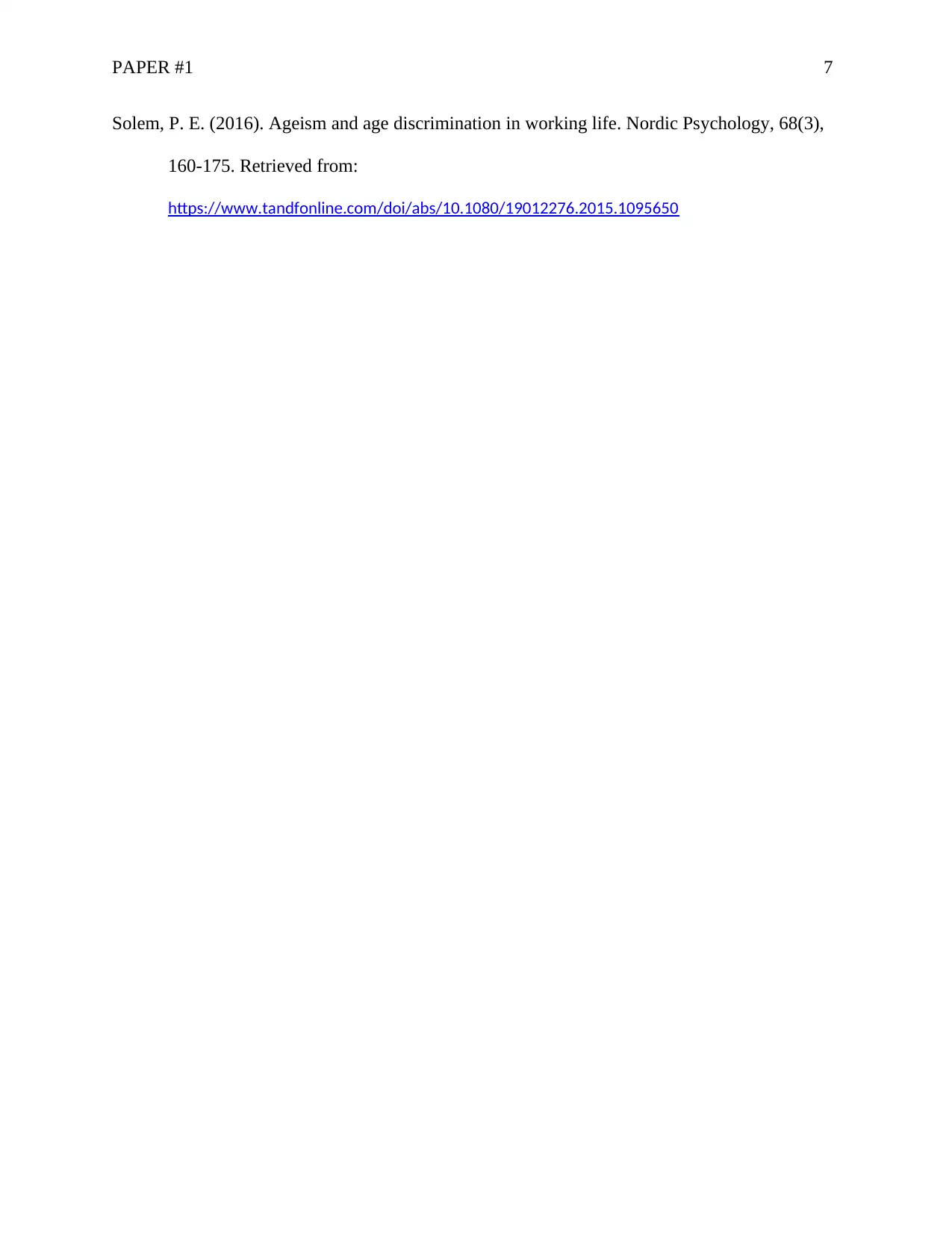
PAPER #1 7
Solem, P. E. (2016). Ageism and age discrimination in working life. Nordic Psychology, 68(3),
160-175. Retrieved from:
https://www.tandfonline.com/doi/abs/10.1080/19012276.2015.1095650
Solem, P. E. (2016). Ageism and age discrimination in working life. Nordic Psychology, 68(3),
160-175. Retrieved from:
https://www.tandfonline.com/doi/abs/10.1080/19012276.2015.1095650
1 out of 7
Related Documents
Your All-in-One AI-Powered Toolkit for Academic Success.
+13062052269
info@desklib.com
Available 24*7 on WhatsApp / Email
![[object Object]](/_next/static/media/star-bottom.7253800d.svg)
Unlock your academic potential
Copyright © 2020–2025 A2Z Services. All Rights Reserved. Developed and managed by ZUCOL.


![Nursing Personal Statement for University Application - [Year]](/_next/image/?url=https%3A%2F%2Fdesklib.com%2Fmedia%2Fimages%2Ffs%2F8b9dc1d7da2e42a582d59123880456ac.jpg&w=256&q=75)


